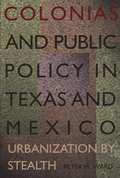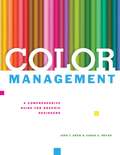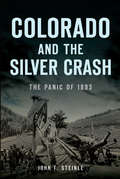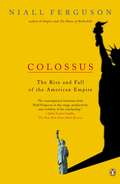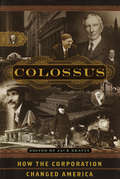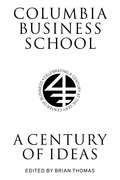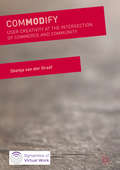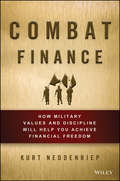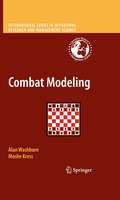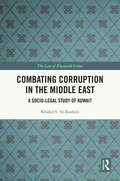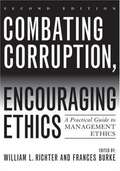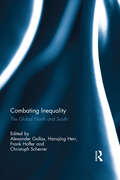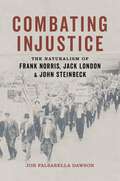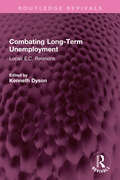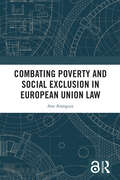- Table View
- List View
Colonias and Public Policy in Texas and Mexico: Urbanization by Stealth
by Peter M. WardToday in Texas, over 1500 colonias in the counties along the Mexican border are home to some 400,000 people. Often lacking basic services, such as electricity, water and sewerage, fire protection, policing, schools, and health care, these "irregular" subdivisions offer the only low-cost housing available to the mostly Hispanic working poor. This book presents the results of a major study of colonias in three transborder metropolitan areas and uncovers the reasons why colonias are spreading so rapidly. Peter Ward compares Texas colonias with their Mexican counterparts, many of which have developed into fully integrated working-class urban communities. He describes how Mexican governments have worked with colonia residents to make physical improvements and upgrade services-a model that Texas policymakers can learn from, Ward asserts. Finally, he concludes with a hard-hitting checklist of public policy initiatives that need to be considered as colonia housing policy enters its second decade in Texas.
Color Kinetics, Inc. (A)
by Das Narayandas Mary Neuner CaravellaTwo-year-old start-up Color Kinetics has developed unique colored lighting technology using digitally controlled LEDs, and has developed that technology into a successful line of products for its first targeted market of "retailtainment." Now in November 1999, the management team is evaluating how to best extend this success into other markets and/or strategic initiatives and achieve the growth it has targeted internally and with investors.
Color Management: A Comprehensive Guide for Graphic Designers
by John T. Drew Sarah A. MeyerWhether they are working in print, interactive, environmental, or web-based design, designers will learn how to apply color theory to their work in order to communicate and entertain. Graphic design professors John Drew and Sarah Meyer explain all of the technical issues that are relevant to communicating with color in 2-D and 3-D environments and in still and moving images. This invaluable guide arms designers with all the in-depth technical information that they need about color theory, color systems, mixing, removal, pigments, inks, papers, and printing. Graphic design students and educators will also appreciate Drew and Meyer’s considerations of how human beings perceive and react to color in every aspect of their daily lives. Featuring over 200 dynamic samples of graphic design and color usage from around the world, this guide is an unrivaled resource and an excellent choice for course adoptions.
ColorWise: A Data Storyteller's Guide to the Intentional Use of Color
by Kate StrachnyiData has become the most powerful tool in business today, and telling its story effectively is critical. Yet one of the best communicators—color—is the most neglected tool in data visualization. With this book, DATAcated founder Kate Strachnyi provides the ultimate guide to the correct use of color for representing data in graphs, charts, tables, and infographics.Ideal for data and business analysts, data scientists, and others who design infographics and data visualizations, this practical resource explores color tips and tricks, including the theories behind them and why they work the way they do. ColorWise covers the psychology, history, and culture of many different colors. This book is also a useful teaching tool for learning about proper use of color for data storytelling techniques and dashboarding.You'll explore:The role that color theory plays in data visualization and storytellingVarious color techniques you can use to improve data visualizationsHow colors affect your audience's understanding of data visualizationsHow to use color intentionally to help guide your audienceTips for using colors that people with color vision deficiency can interpretHow to apply the book's guidelines for use in your own projects
Colorado and the Silver Crash: The Panic of 1893 (Disaster)
by John F. SteinleA catastrophic depression engulfed Colorado in 1893. The government's decision to adopt the gold standard and stop buying silver hit the mining industry like a cave-in. Unemployment reached 90 percent in Leadville, a city built on silver. Strikes by union miners in Cripple Creek and Leadville led to destruction and death. Political parties split along battle lines of gold versus silver. By 1898, the country had begun to recover, but silver mining was never the same. Using firsthand commentary and more than one hundred historic photographs, John Steinle skillfully commemorates the story of Coloradans trapped in the unprecedented social, economic and political conflict of America's first great depression.
Colorscope, Inc.
by V. G. Narayanan Joseph ChaA small company in the graphic arts business faces severe price competition. The company must respond by cutting costs and making process improvements.
Colossus
by Niall FergusonIs America an empire? Certainly not, according to our government. Despite the conquest of two sovereign states in as many years, despite the presence of more than 750 military installations in two thirds of the world’s countries and despite his stated intention "to extend the benefits of freedom...to every corner of the world," George W. Bush maintains that "America has never been an empire." "We don’t seek empires," insists Defense Secretary Rumsfeld. "We’re not imperialistic."Nonsense, says Niall Ferguson. In Colossus he argues that in both military and economic terms America is nothing less than the most powerful empire the world has ever seen. Just like the British Empire a century ago, the United States aspires to globalize free markets, the rule of law, and representative government. In theory it’s a good project, says Ferguson. Yet Americans shy away from the long-term commitments of manpower and money that are indispensable if rogue regimes and failed states really are to be changed for the better. Ours, he argues, is an empire with an attention deficit disorder, imposing ever more unrealistic timescales on its overseas interventions. Worse, it’s an empire in denial—a hyperpower that simply refuses to admit the scale of its global responsibilities. And the negative consequences will be felt at home as well as abroad. In an alarmingly persuasive final chapter Ferguson warns that this chronic myopia also applies to our domestic responsibilities. When overstretch comes, he warns, it will come from within—and it will reveal that more than just the feet of the American colossus is made of clay.
Colossus: How the Corporation Changed America
by Jack BeattyBeatty, a senior editor of The Atlantic Monthly, has gathered a wide array of documents--including sections of books, articles, first-hand accounts, and letters--which he glues together with his own commentary to create a history of the American corporation, from its beginnings in the 17th century to today. His thesis is that corporations cast a shadow over the American economy, society, culture, and politics like a colossus. There is no index. Annotation c. Book News, Inc., Portland, OR (booknews.com)
Colours in the Sky: The History of Autair and Court Line Aviation
by Graham M. SimonsIt's impossible to tell the story of Court Line without telling that of Autair, founded by helicopter pioneer William 'Bill' Armstrong. Autair itself was an offshoot of his global helicopter operation, but Bill also had his finger in many aviation 'pies' including a multitude of operations in Africa, where so many aircraft and airlines were created, bought and sold with such prolificacy that even he could not remember the names and how many there were! There is also the background to Court Line's shipping concerns and the Caribbean operations of the hotel chains and regional airline Leeward Islands Air Transport which Court owned for a while.Covered in detail is the introduction, demonstration and use of the Lockheed TriStar wide-bodied airliner, the first of the type used in the Inclusive Tour business.Court Line Aviation and Tom Gullick's Clarksons Holidays brought to the forefront the concept of value-for-money Inclusive Tour holidays following the 'vertical integration' business model whereby owning and controlling each step of the holiday allowed the company to make a small profit at every stage.The orange, pink, turquoise and yellow jets brought flashes of color to dreary British airports, and quickly streamed a multi-colored rainbow across European skies to Mediterranean destinations and even further afield. Truly they did indeed put colors in the Sky!
Colt Industries
by Jeremy C. SteinColt Industries is a conglomerate that is considering undertaking a leveraged recapitalization. The deal would involve a large one-time dividend to stockholders, which would be financed by over $1 billion in new debt. Unlike in an leveraged buyout, however, public shareholders would still retain an equity interest in the company. Shareholders in the company's employee savings plan would not receive the dividend, but instead would see their percentage ownership in the company substantially increased.
Columbia Business School: A Century of Ideas (Columbiana)
by Brian ThomasFeaturing interviews with topflight scholars discussing their work and that of their colleagues, this retrospective of the first hundred years of Columbia Business School recounts the role of the preeminent institution in transforming education, industry, and global society. From its early years as the birthplace of value investing to its seminal influence on Warren Buffett and Benjamin Graham, the school has been a profound incubator of ideas and talent, determining the direction of American business.In ten chapters, each representing a single subject of the school's research, senior faculty members recount the collaborative efforts and innovative approaches that led to revolutionary business methods in fields like finance, economics, and accounting. They describe the pioneering work that helped create new quantitative and stochastic tools to enhance corporate decision making, and they revisit the groundbreaking twentieth-century marketing and management paradigms that continue to affect the fundamentals of global business. The volume profiles several prominent centers and programs that have helped the school adapt to recent advancements in international business, entrepreneurship, and social enterprise. Columbia Business School has long offered its diverse students access to the best leaders and thinkers in the industry. This book not only reflects on these relationships but also imagines what might be accomplished in the next hundred years.
Columbia Capital Corp.: Summer 1998
by Bill Wasik G. Felda HardymonIn August 1998, the partners of Columbia Capital in Arlington, Va. made a decision about whether or not to raise an outside fund for venture capital investing. Columbia had begun in 1988 as a boutique investment bank focused on the telecommunications industry, but had over its history become progressively more involved in making direct private equity investments; from 1994-98, the firm made over $100 million in such investments. Unlike traditional venture capital firms, however, Columbia made these investments entirely with its partners' own personal money.
Columbia's Final Mission
by Amy C. Edmondson Richard Bohmer Laura R. Feldman Michael A. Roberto Erika M. FerlinsDescribes the 16-day final mission of the space shuttle Columbia in January 2003 in which seven astronauts died. Includes background on NASA and the creation of the human space flight program, including the 1970 Apollo 13 crisis and 1986 Challenger disaster. Examines NASA's organizational culture, leadership, and the influences on the investigation of and response to foam shedding from the external fuel tank during shuttle launch.
ComMODify: User Creativity at the Intersection of Commerce and Community (Dynamics of Virtual Work)
by Shenja van der GraafThis book critically analyses user-firm technology relationships and socioeconomic structures at the crossroads of community and commerce. It investigates businesses that let users participate in platform development on the internet. An empirical study of the online world Second Life is used as an early illustration of the pivotal role of user participation in design, development and sustainability of digital platforms. Van der Graaf sheds light on aspects of the ongoing platformization of the internet and on new norms and mechanisms for user participation which are linked to values of creativity, community and labour. ComMODify makes clear that robust theoretical and empirical investigation of the integration of user participation into mainstream business models and its implications for platform development is key to understanding contemporary businesses like Facebook, that sustain the internet of today. This book will be of interest to those wanting to learn more about the socio-economic implications of user participation associated with user-generated content, particularly within the 3D software and game industry.
Combat Finance: How Military Values and Discipline Will Help You Achieve Financial Freedom
by Kurt NeddenriepIn this book, Kurt Neddenriep, a Senior Vice President at a major investment firm who also served a tour in Afghanistan, develops a set of leadership and service values to help individuals and families to consistently achieve financial success. A comprehensive guide to personal finance, this book is informed by the author's expertise in the financial industry and framed within the lessons, clear thinking and organization he learned over the course of a parallel 23-year career in the Army National Guard of Nevada. The book will tell the stories of those who serve our country and how their values, discipline, and morals can teach us financial lessons in our personal lives, taking military principles and tactics and using them to explain finances for the mainstream American.The book covers:MortgagesSavingsInsurancePortfolio diversity
Combat Modeling (International Series in Operations Research & Management Science #134)
by Alan Washburn Moshe Kress"Combat Modeling" is a systematic learning resource and reference text for the quantitative analysis of combat. After a brief overview, authors Washburn and Kress present individual chapters on shooting without feedback; shooting with feedback; target defense; attrition models; game theory and wargames; search; unmanned aerial vehicles; and terror and insurgency. Three appendices provide a review of basic probability concepts, probability distributions, and Markov models; an introduction to optimization models; and a discussion of Monte-Carlo simulations. Drawing on their many years of experience at the Naval Postgraduate School in Monterey, California, Washburn and Kress have created a reference that will provide the tools and techniques for analysts involved in the underpinnings of combat decisions. This is a book that can be used as a military manual, reference book, and textbook for military courses on this vital subject.
Combating Corruption in the Middle East: A Socio-Legal Study of Kuwait (The Law of Financial Crime)
by Khaled S. Al-RashidiThis book examines the phenomenon of ‘grand corruption’ in Kuwait and the pattern in the wider region. Taking an interdisciplinary approach, the work places corruption in its sociological, political and economic context to explore the relationship between the characteristics of Kuwait as a state with an endemic corruption problem. It then focuses on laws and regulations as key problem-solving mechanisms. In doing so, it identifies, explores, and assesses the existing counter-corruption laws and regulations in Kuwait in a broad socio-political-economic context. The work goes beyond doctrinal legal research, employing empirical methodology based on semi-structured interviews with elite politicians and professional experts from criminal justice and non-governmental organisations (NGOs). These valuable and original insights are reflected upon throughout the study. The grand corruption that permeates the tier of high-profile officials in Kuwait is replicated in many developing countries where accountability mechanisms regularly suffer from lack of enforcement. The appeal of this book is its application to numerous jurisdictions, and the Gulf Cooperation Council (GCC) countries and Middle East in particular. It will be a valuable resource for academics, researchers, and policymakers working in the areas of financial crime and corruption.
Combating Corruption, Encouraging Ethics: A Practical Guide To Management Ethics (Second Edition)
by William L. Richter Frances BurkeIn their second edition of Combating Corruption, Encouraging Ethics, William L. Richter and Frances Burke update this essential staple to delve deeply into the unique ethical problems of twenty-first century public administration. Combating Corruption, Encouraging Ethics offers both the depth demanded by graduate courses in administrative ethics and the accessibility necessary for an undergraduate introduction to public administration.
Combating Inequality: Rethinking Government's Role
by Olivier Blanchard and Dani RodrikLeading economists and policymakers consider what economic tools are most effective in reversing the rise in inequality.Economic inequality is the defining issue of our time. In the United States, the wealth share of the top 1% has risen from 25% in the late 1970s to around 40% today. The percentage of children earning more than their parents has fallen from 90% in the 1940s to around 50% today. In Combating Inequality, leading economists, many of them current or former policymakers, bring good news: we have the tools to reverse the rise in inequality. In their discussions, they consider which of these tools are the most effective at doing so.
Combating Inequality: The Global North and South
by Alexander Gallas Frank Hoffer Christoph Scherrer HansjEconomic inequality has recently gained considerable academic attention. However, two important aspects of inequality have not been discussed systematically: its multidimensional nature and the question of what can be done to reverse it. This book offers insights from scholars representing the Global Labour University, which operates in Brazil, Germany, India, South Africa and the US. They analyse the various drivers of inequality, assess policy responses, and discuss counterstrategies. The main findings of this book are that rising levels of inequality cannot be addressed only with the standard policies responses, namely education, redistribution and ‘green growth’. In addition, the way markets currently function needs to be corrected. The chapters in this volume focus on specific fields of contemporary capitalism where important drivers of inequality are located, for example, the labour market; the financial system; the tax system; multi-national corporations; and gender relations. Other chapters discuss in detail where political opportunities for change lie. They critically assess existing countermeasures; the idea of a ‘green economy’ and its implications for inequality; and existing campaigns by trade unions and new social movements against inequality. In line with the global nature of the problem, this book contains case studies on countries both from the north and south with considerable economic and political weight. This book provides academics, political practitioners and civil society activists with a range of ideas on how to drive back inequality. It will be of interest to those who study political economy, development economy and labour economics.
Combating Injustice: The Naturalism of Frank Norris, Jack London, and John Steinbeck
by Jon Falsarella DawsonIn Combating Injustice, Jon Falsarella Dawson approaches American literary naturalism as a means of social criticism, exploring the powerful economic arguments and commentaries on labor struggles presented in novels by Frank Norris, Jack London, and John Steinbeck. Making use of extensive archival research, Dawson considers many of the original periodical sources that fueled books from McTeague to The Grapes of Wrath, as Norris, London, and Steinbeck transformed contemporary materials into illustrations of the socioeconomic forces that shape American life. By depicting the operations of powerful individuals and institutions, these naturalist writers offered audiences a greater awareness of the plight of labor so that readers might find the inspiration to become agents of change. Works such as The Octopus, The Iron Heel, Martin Eden, and In Dubious Battle illuminate many of the central economic issues at play in the United States during the late nineteenth and early twentieth centuries, including the rise of commodity culture, labor disputes involving industrial and agricultural workers, widespread poverty, extreme inequality, and the concentration of resources and land ownership. Norris, London, and Steinbeck highlighted the dangers of these developments by charting their impact on central characters whose fates result from the predatory tactics of corporate monopolies, wealthy individuals, and large financial establishments. Dawson’s lucid analysis shows how all three writers, drawing on contemporary events, accentuated the need for reform and stressed the potential for change by human action. Each author took inspiration from notable events in California, ranging from the Mussel Slough tragedy of 1880 to the agricultural strikes in the Central Valley during the 1930s, presenting the state as a microcosm for conditions throughout the nation during a period of tremendous upheaval. Combating Injustice: The Naturalism of Frank Norris, Jack London, and John Steinbeck provides carefully contextualized readings of three major writers whose works express both the necessity for and the possibility of creating a more egalitarian society.
Combating Long-Term Unemployment: Local/ E.C. Relations (Routledge Revivals)
by Kenneth DysonFirst published in 1989, Combating Long-Term Unemployment follows on from, and is a companion to, Local Authorities and New Technologies. The book seeks to inform debate by analysing policy responses to the problem of long-term unemployment and by focusing on the role of local initiatives in a European context. Long-term unemployment in Europe is a complicated and multifaceted problem, the policy responses to which need to be studied against various contexts. It is designed to appeal to all those interested in policies to combat long-term unemployment: local and central government officials, private sector organizations whose work is relevant to locally based initiatives, and interested academics.
Combating Poverty and Social Exclusion in European Union Law
by Ane AranguizThis book examines the potential role of European Union law in combating poverty and social exclusion in the European Union. Anti-poverty strategies have been part of the European Union agenda for decades. Most saliently, over a decade ago, the EU’s Member States pledged to lift 20 million people out of poverty. In spite of this commitment, the EU did not even meet a quarter of this target, and over 113 million people still were at risk of poverty and social exclusion by the end of 2020. This book addresses the incongruence between a quite developed EU policy strategy and a well-embedded legal objective on the one hand, and the lack of direct legal action on the other. Analysing the role of social policy instruments, fundamental rights, and the constitutional framework of the European Union, it makes a detailed case for a contribution of EU law to the policy objective of combating poverty and social exclusion. Drawing on work in law, politics, social policy and economics, this book will interest scholars and policymakers in the areas of EU law, labour and social security, human rights, political science and social and public policy.
Combating Poverty and Social Exclusion in European Union Law
by Ane AranguizThis book examines the potential role of European Union law in combating poverty and social exclusion in the European Union.Anti-poverty strategies have been part of the European Union agenda for decades. Most saliently, over a decade ago, the EU’s Member States pledged to lift 20 million people out of poverty. In spite of this commitment, the EU did not even meet a quarter of this target, and over 113 million people still were at risk of poverty and social exclusion by the end of 2020. This book addresses the incongruence between a quite developed EU policy strategy and a well-embedded legal objective on the one hand, and the lack of direct legal action on the other. Analysing the role of social policy instruments, fundamental rights, and the constitutional framework of the European Union, it makes a detailed case for a contribution of EU law to the policy objective of combating poverty and social exclusion.Drawing on work in law, politics, social policy and economics, this book will interest scholars and policymakers in the areas of EU law, labour and social security, human rights, political science and social and public policy.The Open Access version of this book, available at www.taylorfrancis.com, has been made available under a Creative Commons Attribution (CC-BY) 4.0 license.
